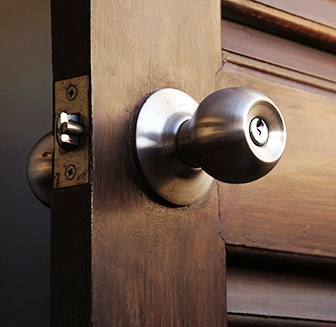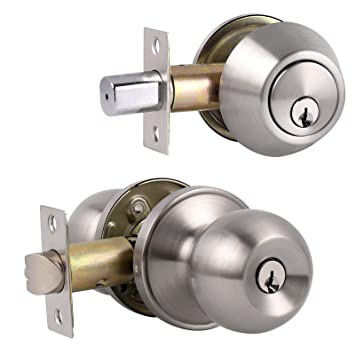🕑 Reading time: 1 minute
Door locks are an essential part of any residential or commercial space. They provide safety and security like no other appliance or tool. Often underestimated and overlooked, the selection of door locks should be done carefully to meet your specific requirements.
Contents:
1. Knob Locks
Knob locks are the most common type of door lock installed on the internal doors. Knob locks are not ideal for external use due to their limited amount of security. But these locks can be installed on exterior doors to provide extra security when used with deadbolt locks.
Doorknob locks have a locking mechanism within the doorknob. These locks have knobs on either side of the door, depending on the possibility of locking the door from the inside or outside.

2. Mortise Locks
Mortise locks are powerful locks and are widely used for commercial doors, entry glass doors, and apartment doors. A mortise lock generally consists of intricate hardware mounted in the door and is held in place by a set screw and utilizes a cam to actuate the locking hardware.
There are many different types of mortice cylinder locks, including three lever mortice locks and five lever mortice locks. The number of levers in a mortise lock tells how many points the door locks into the frame. The more levers it has, the more secure it will be.

3. Padlocks
Padlocks are one of the simplest types of door locks, which are portable, meaning unlike other types of locks, they are not permanently attached to a door or anything that uses it. The padlocks can be fixed to a door, gate, chain, or fence to secure a space and prevent theft or vandalism. They contain a shouldered shackle, a part in which the padlock shoulders raise the sides of the shackle to inhibit bolt cutters from cutting through it.
Padlocks come in a variety of models that are grouped into two main categories.
- Keyed padlocks work with a key that turns when inserted to release the lock. The keyed padlocks come in non-re-keyable and re-keyable types. It's not easy to change the key to non-re-keyable padlocks. Also, the locks can be either key retaining or non-key-retaining. Key-retaining padlocks don't allow the key to be pulled out once you open the lock. Latches with shrouded shoulders make it hard for an intruder to cut your lock.
- Combination padlocks have dials with several digits or letters that can be rotated. Once these are lined up into the correct combination, the padlock will release, and the lock can be opened. These locks are useful because they don't require a key. These types of locks are easy to shim or decode.


4. Deadbolt Lock
Deadbolts are unarguably one of the most popular type of door locks, and they are widely used for residential properties. They are opened by turning a knob or key without the use of a spring. Deadbolts feature a unique locking mechanism that reduces the risk of forced entry by creating a secure lock system that makes it nearly impossible for a burglar to break in through the door.
Deadbolt locks come in three different types
4.1 Single Cylinder Deadbolts
Single-cylinder deadbolts use a key cylinder on the outside and a thumb turn (rosary) on the inside to open or close the lock. These deadbolts have one primary weakness, and if access to the inside is possible (via a nearby window or even through the peephole using simple tools), the door can be opened using the thumb turn.

4.2 Double Cylinder Deadbolts
A double-cylinder deadbolt uses a key cylinder on the inside and outside the door to solve this issue. These have the clear disadvantage of always requiring a key to open the door from the inside if it is locked. This can pose a significant problem in an event of fire or other emergencies.

4.3 Lockable Thumbturn
Lockable Thumbturn deadbolt is a hybrid between a single and a double deadbolt. It features a thumb turn on the inside that works like a normal single cylinder deadbolt, except that the thumb turn can be locked using a key so it cannot lock or unlock the door. The thumb turn can be easily locked so that even if someone has access to the door from the inside, the deadbolt cannot be unlocked. This type of deadbolt provides maximum flexibility and security in most situations.

5. Electronic Locks and Smart Locks
Electronic locks do not require keys to lock and unlock them; instead, they have a keypad or card system in which you can use a special code or key. These keyless locks are common in hotel rooms and offices and are becoming increasingly popular for apartment buildings and residential properties.
Electronic locks can track how often they are used and can even create a log mentioning the time of entry and departure to a room or property. If different people use different keycards, it can also record which person had accessed the lock, making it easier to find out who accessed the property at a certain time. This can help in maintaining better security practices and also be useful in case any suspicious activity observed.

Smart locks are a new type of door locks that are rapidly gaining popularity and changing how people manage the security of their homes. The smart lock has to receive a specific set of instructions from an authorized device for it to be locked and unlocked. These instructions are usually transmitted wirelessly, and they adhere to wireless communication protocols.
One can also unlock your door remotely using your smartphone. This might come in handy when you have to leave town unexpectedly, and you want to allow someone into your home to feed your pet or turn off your heating.

Read More
How to Fix Doors and Windows in Wall Openings?
How to Cast and Fix Precast Concrete Door and Window Frames?
18 Types of Fixtures and Fastenings for Doors and Windows

